My NativeScript learning conspectus.
Maximilian Schwarzmüller NativeScript Lecture
- 1. Introduction
- 1. Course Introduction
- 2. What is NativeScript
- 3. Under the Hood of NativeScript
- 4. What is Angular & Course Requirements
- 5. Our First NativeScript App!
- 6. Course Outline
- 7. How To Get The Most Out Of The Course
- 2. Optional Angular - A Quick Refresher
- 1. Module Introduction
- 2. What is Angular
- 3. Single Page Applications (SPAs) in Angular & NativeScript
- 4. Understanding Components
- 5. Installing Angular with the Command Line Interface (CLI)
- 6. Installing our IDE
- 7. Understanding the Angular Project Folder Structure
- 8. The App Component
- 10. Cross Component Communication with Property Binding
- 11. Understanding Directives & String Interpolation
- 12. Handling User Input
- 13. Understanding Event Binding
- 14. Executing Methods with Local References
- 15. Understanding Two Way Binding
- 16. Passing Data Up With a Custom Event
- 17. Implementing Routing
- 18. Setting Up Services
- 19. Using the Service with Dependency Injection
- 20. Working with Lifecycle Hooks
- 21. Adding a Person with Services
- 22. Navigating Between Components
- 23. Removing Items On Click
- 24. Implementing an Active Push Mechanism
- 26. Sending HTTP Requests
- 27. Showing a Placeholder Whilst Waiting for a Response
- 28. Wrap Up
- 3. Setting Up the Development Environment
- 1. Setting up NativeScript on macOS
- 2. Setting up NativeScript on Windows
- 4. Using Different Emulator Devices
- 6. Running the App on a Real Device
- 7. What's Up With The Extra .js Files
- 4. Understanding the Basics
- 1. Module Introduction
- 2. Starting the Emulators
- 3. How Does The App Start
- 4. Understanding Components & Layouts
- 5. Building our First own Component
- 6. Adding Basic Element Interactions
- 7. Understanding the Styling Basics
- 8. Styling a Button
- 10. Understanding Layouts - Theory
- 11. The StackLayout
- 12. The FlexboxLayout
- 14. The GridLayout
- 16. Understanding the AbsoluteLayout
- 17. Implementing the Grid Layout in the Course Project
- 18. Splitting our App Into Components
- 19. Passing Data Between Components
- 20. Creating a List of Items
- 21. Making the List Scrollable
- 22. Using the ListView
- 23. Extracting & Rendering Dynamic Values
- 24. Debugging our Application
- 26. Wrap Up
- 5. Diving Into App Navigation
- 1. Module Introduction
- 2. Understanding the Different Navigation Options
- 3. Planning the App
- 4. Creating the App Pages
- 5. Adding our First Route
- 6. Implementing Page Navigation
- 7. How to Add Forward & Backward Navigation to our App
- 8. Understanding the Router Object
- 9. Working with the nsRouterLink Directive
- 12. Adding an Actionbar and a Back Button
- 13. Creating a Shared Component for the Back Button
- 14. Adding Logic to the Back Button
- 15. Overwriting the Default Transition Effect
- 16. Adding the TabView Component
- 17. Displaying Dynamic Routing Content in the Tabs
- 18. Highlighting the Currently Active Tab
- 19. Adding a Sidedrawer
- 20. Adding the Sidedrawer Icon
- 21. Rendering the Button on Android Only
- 22. Forwarding the Button is Pressed Info to the App Component
- 23. Displaying the Sidedrawer
- 24. Implementing the Logout Logic
- 25. Passing Around Dynamic Data
- 26. Reading Dynamic Parameters
- 27. Using the Dynamic Parameter
- 28. Injecting Dynamic Values Into the Action Bar on Per Page Level
- 29. Opening a Modal
- 30. Getting Access to the viewContainerRef
- 31. Passing Data Into the Modal
- 33. Loading Routes Lazily - Theory
- 34. Implementing Lazy Loading
- 35. Loading Additional Modules Lazily
- 36. Adding a Missing Schema
- 37. Wrap Up
- 6. Styling our App
- 1. Module Introduction
- 2. CSS in NativeScript - An Overview
- 3. Understanding Platform Specific Inline Styles
- 4. Platform Specific Files
- 5. Setting Properties Via CSS
- 6. How CSS Works Behind the Scenes
- 7. Using a Theme
- 8. Working with SASS Variables
- 9. Styling the Action Bar10. Preparing the Form Styling
- 11. Centralizing Common Styles
- 12. Styling Today's Challenge
- 13. Working on the Current Challenge
- 14. Adding the Grid to the Current Challenge
- 15. Populating the Grid
- 16. Styling the Grid
- 17. Opening the Modal when Tapping a Day
- 18. Fixing the Sidedrawer Button & Adding Icons
- 19. Adding Text Fonts
- 20. Integrating Images
- 21. Adding Icon Images
- 22. Improving the Logout Button Look
- 23. Wrap Up
- 7. Adding Forms
- 1. Module Introduction
- 2. Configuring Form Inputs
- 3. Adding Form Validation
- 4. Did you Solve your Challenge
- 5. Submitting Form Inputs
- 6. Adding a Login Form
- 7. Setting up the Reactive Form
- 8. Adding Validation & Reading Form Values
- 9. Showing the Validation Text in the Template
- 10. Switching Between Login & Signup
- 11. Wrap Up
- 8. Understanding State
- 1. Module Introduction
- 2. Analyzing the Requirements
- 3. Working on the Challenge Service
- 4. Adding the Challenge & Day Models
- 5. Using the Challenge Model
- 6. Using the Challenge Service
- 7. Rendering the Current Challenge
- 8. Working on the Today Page & State
- 9. Preparing the Update Day Status Logic
- 10. Updating the Day Status for Today
- 11. Reflecting the Day State on the Action Buttons
- 12. Adding Animations
- 13. Controlling the Settable Days
- 14. Setting the Day Status via the Modal
- 15. Reflecting the Current Day's State
- 16. Changing the Cancel Logic in the Modal
- 17. Resetting Today's State Correctly
- 18. Updating an Existing Challenge
- 19. Disabling the Edit Button
- 20. Wrap Up
- 9. Storing Data on the Backend
- 1. Module Introduction
- 2. Setting Up the Firebase Database
- 3. Storing a New Challenge in the Database
- 4. Fetching Data From the Backend
- 5. Displaying the Loaded Data
- 6. Updating Challenges
- 7. Disabling the Failed Button
- 8. Wrap Up
- 10. Adding Authentication to our App
- 1. Module Introduction
- 2. How Authentication Works
- 3. Signing Users Up
- 4. Logging Users In
- 5. Handling Errors & Showing Alerts
- 6. Creating a User Object & Storing the Token
- 7. Managing the User in the Auth Service
- 8. Attaching the Auth Token to Requests
- 9. Authenticating All Requests
- 10. Adding Logout
- 11. Checking the Authentication State
- 12. Adding Auto Login
- 13. Adding Auto Logout
- 14. Adding an Authentication Guard
- 15. Fixing the Redirection Path
- 16. Adding Authorization
- 17. Wrap Up
- 11. Deploying our App
- 1. Module Introduction
- 2. The Publishing Process
- 3. Testing our App on Different Devices
- 4. Adding the App Icon & Splash Screen Icons
- 5. Further Resources
- 6. Publishing the iOS App
- 7. Publishing the Android App
- 12. Code Sharing
- 1. Module Introduction
- 2. How Code Sharing Works
- 3. Creating a Shared Project
- 4. Analysing the Project Structure
- 5. Running the Apps
- 6. Adjusting the Auth & App Modules
- 7. Using Helper Services
- 8. Finishing the Auth Component & Adding Styles
- 9. Working on the Auth Form Styling
- 10. More Auth
- 11. Adding More Helper Services
- 12. Finishing the Authentication Part
- 13. Starting Work on the Challenges Part
- 14. Working on the Today Page
- 15. Working on the Challenge Edit Component
- 16. Fixing the Challenges Filenames & Imports
- 17. Adding the ActionBar
- 18. Reaching the Challenge Edit Page
- 19. Adding the Auth Guard & Auto-Login
- 20. Working on the Current Challenge Page
- 21. Adjusting the Styles
- 22. Resetting the Editing Page Correctly
- 23. Fetching the Current Challenge on Multiple Pages
- 24. Adjusting the Navigation Items
- 25. Navigating Back (Correctly)
- 26. Adding a Web Modal
- 27. Adding a Backdrop for the Modal
- 28. Adding Modal Actions & User Interactions
- 29. Reflecting the Day Status in the Modal
- 30. Populating the Grid Correctly
- 31. Logging Out
- 32. Adding a Loading Indicator
- 33. Finishing the Mobile Apps
- 34. Wrap Up
- 13. Roundup
- 1. Roundup & Next Steps
- 2. Using the Official Resources
Key futures
- 1. NativeScript project overview
- 2. Code sharing
- 3. Debug
- 4. Demo project overview
- 5. NS Layout is position, Layout has no refletion to Android and IOS, its only absttaction.
- 6. NS Components
- 7. Common developmet workflow on NS Angular.
- 8. Create your first NS component
- 9. Styling app
- 10. Communication between components - Event emitter
- 11. ScrollView UI component
- 12. Manage state, Services
- 13. Service
- 14. RxJs component - BehaviorSubject (asObservable)
- 15. Special Navigation for Mobile Phone - Stack based, Tab based, Drawer based>
- 16. Platform depended future - we will create special navigation icon for Androis only and tune it style
- 17. Continue improve app navigation
- 18. TabView navigation
- 19. Styling
- 20. Animation
- 21. Forms
- 22. Working with backend, This project use Firebase
- 23. Spiner
- 24. Authentication
- 25. NativeScrip Alert finction is working!
- 26. Start Authorization on Firebase, unlock databases for Users
- 27. Create persistent UserId
- 28. Create Lazy loading AuthModule
- 29. And finally made authorization on Firebase, each user has own chalenge in Firebase.
- 30. Deploynment.
(*) Also need to take EggHead lecture:
- Create Native Mobile Apps with NativeScript for AngularNathan Walker・43m・Course
- Create Angular iOS and Android AppsNathan Walker・1h 9m・Course
1. NativeScript project overview
3-rd party library (Dropdown, Firebase, Calendar and so on)

NS Clipboard component
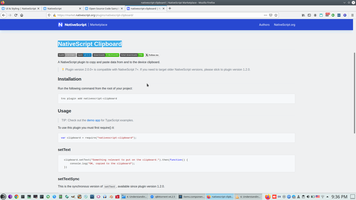
NS Secure storage component, Android Hawk


NS repository (230 items)

SqLite

NS Showcase - Project builded on NS

Stackblitz

6 main NS template projects on Ts and Angular, Ts without Angular projects

Code for this lecture

2. Code sharing
- 1. Module Introduction
- 2. How Code Sharing Works
- 3. Creating a Shared Project
- 4. Analysing the Project Structure
- 5. Running the Apps
- 6. Adjusting the Auth & App Modules
- 7. Using Helper Services
- 8. Finishing the Auth Component & Adding Styles
- 9. Working on the Auth Form Styling
- 10. More Auth
- 11. Adding More Helper Services
- 12. Finishing the Authentication Part
- 13. Starting Work on the Challenges Part
- 14. Working on the Today Page
- 15. Working on the Challenge Edit Component
- 16. Fixing the Challenges Filenames & Imports
- 17. Adding the ActionBar
- 18. Reaching the Challenge Edit Page
- 19. Adding the Auth Guard & Auto-Login
- 20. Working on the Current Challenge Page
- 21. Adjusting the Styles
- 22. Resetting the Editing Page Correctly
- 23. Fetching the Current Challenge on Multiple Pages
- 24. Adjusting the Navigation Items
- 25. Navigating Back (Correctly)
- 26. Adding a Web Modal
- 27. Adding a Backdrop for the Modal
- 28. Adding Modal Actions & User Interactions
- 29. Reflecting the Day Status in the Modal
- 30. Populating the Grid Correctly
- 31. Logging Out
- 32. Adding a Loading Indicator
- 33. Finishing the Mobile Apps
- 34. Wrap Up

tools - share code between mobile apps and Web

NativeScript library

3. Debug
'ns debug --bundle' compose all together

Start debugging

Chrome Debugger

Console log redirect to Chromw debugger
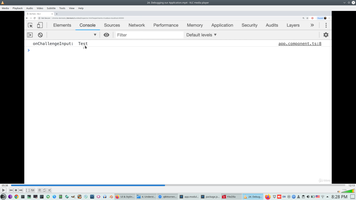
Look to TypeScript code on Debugger

Set Breakpoint

Debug inside Vs Code


Breakpoint inside Vs Code

4. Demo project overview

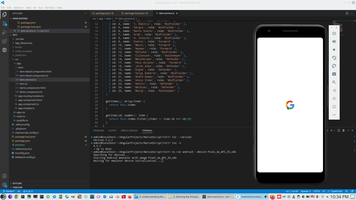



Details

Required library

Compilation options - target and other

Starter


DevTools inspector

Router and main component

Item component and router link

Service to generate data

Array.Filter

Detail component

Bind all component together

This is way to avoid Angular engine finding Html and checking it

5. NS Layout is position, Layout has no refletion to Android and IOS, its only absttaction.


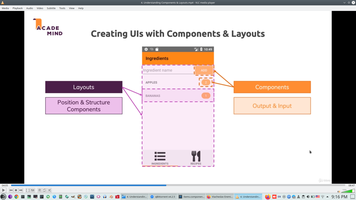

Layout types


Plus Root laout in other version
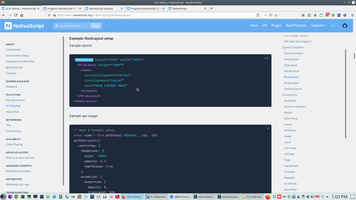

More details how to use GridLayout, column property, try to insert two component to Grid




Return to Stack

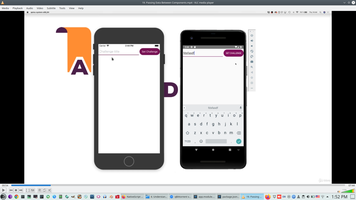
6. NS Components
How components translative to Native

All UI components

Reflect NS component to Native (Android, IOS)


7. Common developmet workflow on NS Angular.
Create component without NG G, create 3 files - *.html, *.ts, *.css

Export class

Add component decorator

Bind code, template and CSS together

Add component to project module list

Add declaration

Start building Component from Layout

Add content to Layout

Include component to application logic, in this case this is root component
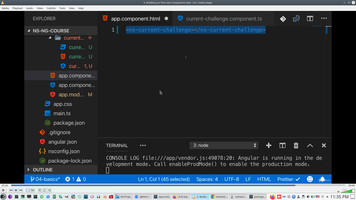

See result

8. Create your first NS component
Creare variable to receive text

NgModel (two way bining - '[()]') allow accept variables from Textbox

For working with user input and unlock NgModel need to import Forms module


See all attributes and description of UI controls

Also see description of properties of each UI controls

In this case we use Hint attribute
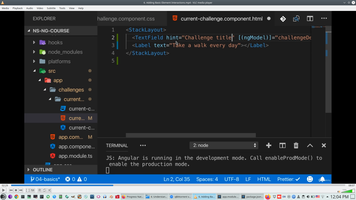
And check how control will working with attributes

Gestures

Gestures Tap event, '()' - allow to bind code to event,


'[]' - property binding.

Pass value from Textbox to Label

Check result


9. Styling app

supported CSS properies

Supported CSS selectors (as static CSS property and dynamically on TS)




Font size use digital value without 'px', device mappping this digital value to pixels.

Style can adding as property and into Style property

Also we can add common UI style of component

Check style

Style can add globally to whole apps


Global styling appplied to global componen


Styling with class description



10. Communication between components - Event emitter
RaiseEvent


EventSubscriber


$event - automaitc parameters of each events

Pass event to property


Check

Pass array between components


*NgFor repeater is a directive can render array in cyrcle

Check

11. ScrollView UI component

Add component dynamically wit TS


Check

ViewPort


Virtualisation of ScroolView

ListView component contains ng-tempate, ng-template provided by Angular, not NS

Difference between IOS and Android


'let-' - special variable for ng-template
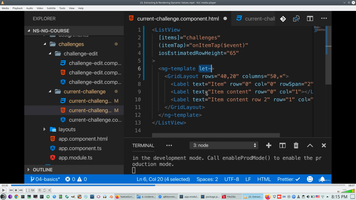

Property binding to specail variable



Index of ListItem element

12. Manage state, Services
State lost when application refeshing

13. Service
Inject service, '{}' - JS object pass as parameter

Service start with @Injectable - set\rvice decorator


Lazy loading - Provide service on top level of application adn remove 'providedIn:root', than add service only to one component.


Service can not be added to top level component

14. RxJs component - BehaviorSubject (asObservable)

Has Generic future

Can raise event with empty object

Create class for using as event parameter

If we add add parameters to constructor it cann see on all class

Public parameters can accesible outside module

Interface with Enum

Import interface to Class

Currently we create a function for each day


Use Array.Find function for select a day characteristics

Return copy of array with spread syntax '...'
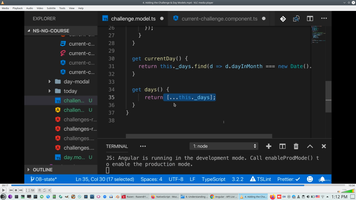
And noew BehaviorObject can emit types events

This is current code


Create external asObservable property


Result of show days characteristics
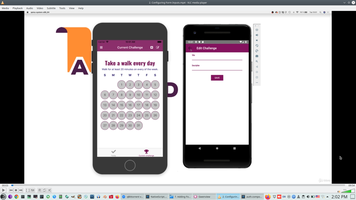
15. Special Navigation for Mobile Phone - Stack based, Tab based, Drawer based
>
Planning application navigation

Create new components by 'ng g c xxx'


RadSlideDrawler contains only Logout function

Add routing module manually

Import NS routing instead Angular Routing


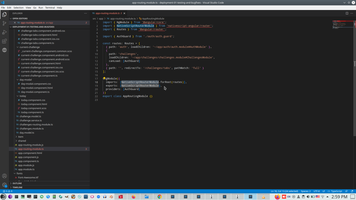
Router-outlet can start app with empty path ''

'router-outlet' include SPA-page navigation to start component

We can inject router module to any component

And use Router.Navigate for go to needed page

Mobile phone app is not a SPA page, therefore we need replace normal Angular router to NS page wrapper to components 'page-router-outlet'
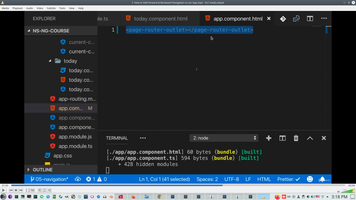
Nornally 'page-router-outlet' show '<back' button on IOS and nothing on Android

We can inject Routing as NS RouterExtension module, this module has mo method, for example - can we go back? (to prevent exit)


Also extension has animation property for navigation between page

Check routing

We can use in button nsRouterLink property

And ClearHistory property to prevent application exit

Currently we will use ActionBar UI component for top on all pages with page title


We can add custom navigation button on IOS


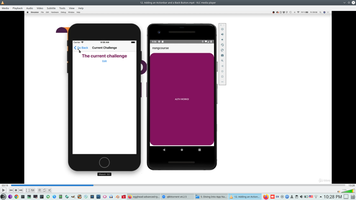
For Android we need to use special Android Icon
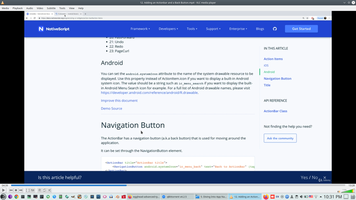


16. Platform depended future - we will create special navigation icon for Androis only and tune it style

Firstly need to import platform
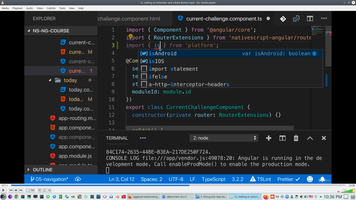
Than use platform specific code


For receive access to any UI item we need to import page component

Now we have access to ActionBar
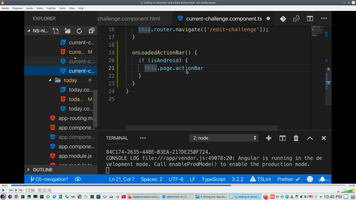
And access to NativeView

Import all Android variable

And Finally we can change style of Android Back button, (need add 'any' for android type)

And bind this code to 'loaded' event of ActionBar

Check it, button 'Back' has our custom color

17. Continue improve app navigation
Now we move platform depended ActionBar from page to separate component


Make input parameter 'title' to ActionBar component

And setup it for each page

This is final code for shared component
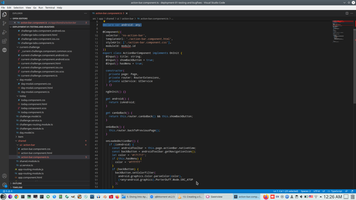


And with Drawler
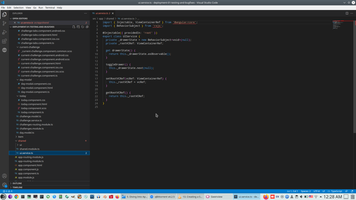

18. TabView navigation

Access for routing parameters

*TabViewItem
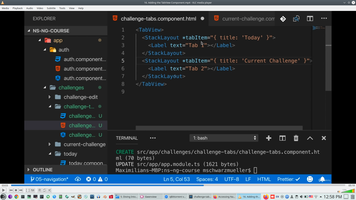
This is Router array

And routing path on Button

Check Tb navigation

Add nested navigation inside tab


Add children navigation to Router array

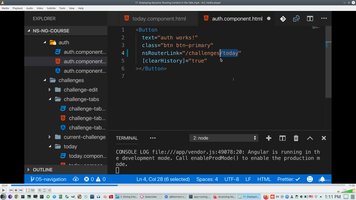
With parameter Outlet, this is Angular Future

We can add Outlet parameters dymamically


And we need to inject ActivatedRoute class for access to router additional metadata

Check how navigation inside Tab working



Inject Page ooject and hide some UI component on page


Altarnate way - move tabItem to StackLayout

Read metadata from ActivateRoure


19. Styling
- 1. Module Introduction
- 2. CSS in NativeScript - An Overview
- 3. Understanding Platform Specific Inline Styles
- 4. Platform Specific Files
- 5. Setting Properties Via CSS
- 6. How CSS Works Behind the Scenes
- 7. Using a Theme
- 8. Working with SASS Variables
- 9. Styling the Action Bar10. Preparing the Form Styling
- 11. Centralizing Common Styles
- 12. Styling Today's Challenge
- 13. Working on the Current Challenge
- 14. Adding the Grid to the Current Challenge
- 15. Populating the Grid
- 16. Styling the Grid
- 17. Opening the Modal when Tapping a Day
- 18. Fixing the Sidedrawer Button & Adding Icons
- 19. Adding Text Fonts
- 20. Integrating Images
- 21. Adding Icon Images
- 22. Improving the Logout Button Look
- 23. Wrap Up

Various selectors

Global styling>

We can pass parameter to another global styleing

Platform specific CSS

Prefix supported in styling on CSS, event, text



Check IOS only style


20. Animation


Step one, define KeyFrames with tramsformation: from - to
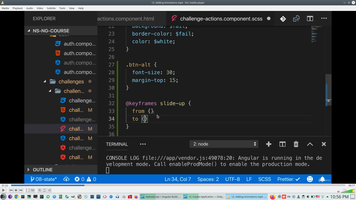
Than define class referred to KeyFrames with other animation parametres - iteration count, duration, direction


Check


21. Forms
Template-driven and Reactive forms, reactive means all configured in TS code. Template based not full supported on NS, because tag FORMS missing in NS.

In this project ChalengeEdit id Template-Driven form


Reacrive forms used in this project in Auth module





More details ...
22. Working with backend, This project use Firebase

Place to insert code
>
Firtly need import HttpClient from NS and Inject it



For writing to server we will use PUT method
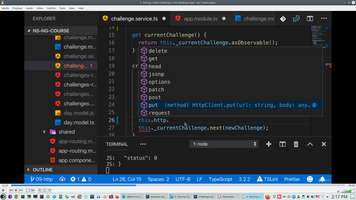
Copy Firebase URL
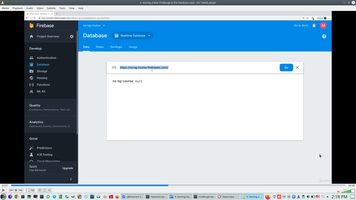

For Firebase we always need to add JSON on the end

Second parameter Data, and we need to Subsribe in order to receive result


Or return Obsevable from this method

But currently we only see result on console

Try to see result of first test writing to Firebase




Try to first read

Read can be typed

We can pass JS object directly to this place to receive typed result


We can return result as Observable
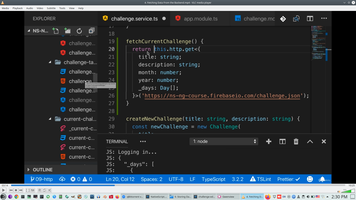
23. Spiner
Inject service in right place and understand routing


Create IsLoading flag

Try Fitch result and check corret place to receive result
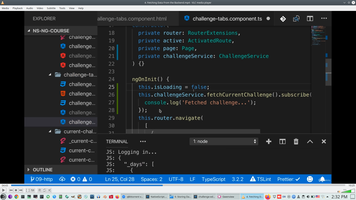

Change flag true/false before and after result received

Handle not answered server


Add Spiner on the form *ngIf

Add ActivityIndicator and tune it


Change place to going to needed URL after Fitch result, move code to subsribe branch, if server serpond correctly




Look to Spiner

24. Authentication
Firebase check login/pass and if it valid Firebase return JWT and we need append thaty JWT as header to each request.
Cuprently project has empty authentication
>

We will add FireBase AU
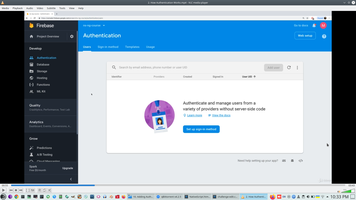
Various type of Firebase AU

We select simple eMail/Pass AU

We need create POST request with parameters



Currently we instantly after login redirect to /chalenge

We start to add AU from servie AuthService
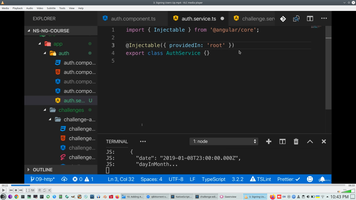
Service need 2 base method - login and Signup

Service will based on standard Angular http client

Firstly copy ApiKey from FireBase


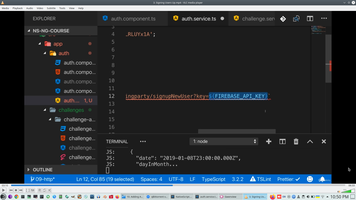
Second parameter of POST request is data



Pass JS object as parameters
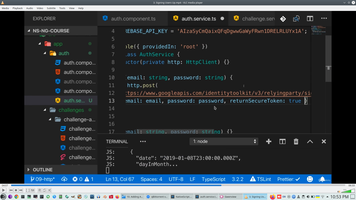
Subscribe handles when POST request will finish, Farebase return JWT


First attempt to signUp, Firebase create new user and we receive JWT




Verify pass

Add application logic if AU service return correct token and processing error if no





Add spinner

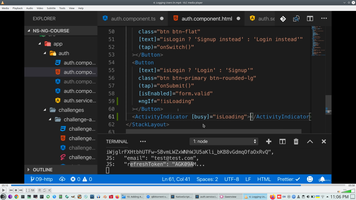
Check spinner

Check bad SignUp branch
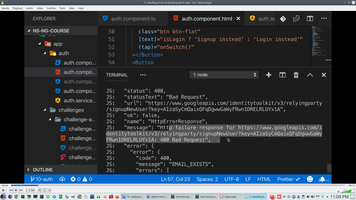

Import ThrowError and CatchError from RxJs


Import RxJs Pipe and CatchError, Pipe function let's you chain RxJS operators, Pipe function returns a new Observable each time https://rxjs.dev/guide/operators, https://thinkrx.io/rxjs/pipe/, interesting that Angular also has Pipe operator - https://angular.io/guide/pipes

And insert ThrowError and CatchError into Pipe

Handle error in separate function
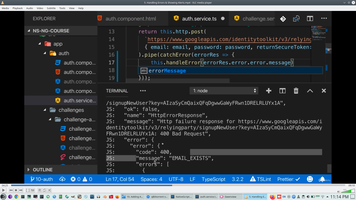

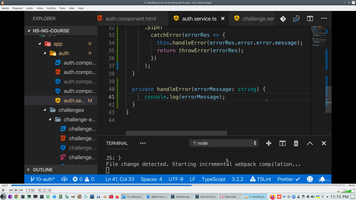
Common Firebase error on Login and Signup

Handle that errors

25. NativeScrip Alert finction is working!
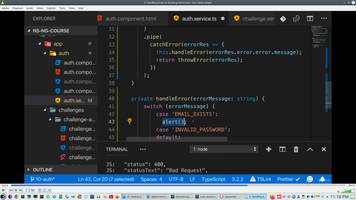




26. Start Authorization on Firebase, unlock databases for Users
Changing default databse rules to access databse only for Authenticated users



And check rules

Currently all users store own data only one place - one for all users

Create class to store User information

Import Tap from RxJs https://rxjs.dev/api/operators/tap

Create types post request




Tap is possible second argument of Post request, we create new User on Tap based on typed response

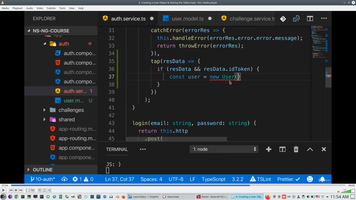

But problem with data, we need convert data to milliseconds and calculate experied date


And finally we create new User with correct token experied time


We have new user, but still don't use it, now we create BehaviorObject from RxJs allow to subscribe https://rxjs.dev/api/index/class/BehaviorSubject

Now User will return asObservable

Next method emit User event https://www.learnrxjs.io/learn-rxjs/subjects/behaviorsubject

Firebase response can emit additional extra field, we set up response with optional parameter

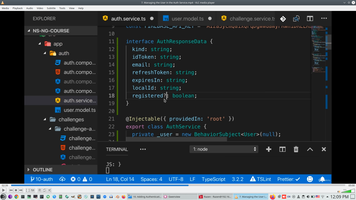
For add AU Header to any request we need to Inject Auth service to Chalenge service


But we need inject on observable result to another observable, in order to do this we need to use SwitchMap https://thinkrx.io/rxjs/switchMap/, https://rxjs.dev/api/index/function/switchMap
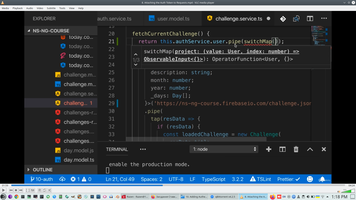
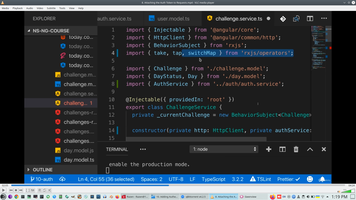
Build correct logic, firstly we receive User than inject User class Header to Autorized request to Firebase




Check how it working




27. Create persistent UserId
If we close app currnly, we need login again



Because logout emit null user



Firstly we need to check token status, is it experied?

!! = double exclamation convert token to boolean (novalue converted to false)

We will store to server only correct User Token

ApplicationSetting allow store simple KeyValue data to Application Setting storage

This four methods allow store, retrieve and delete string Key

We strinfy User object to Json string

Import OF from RxJs https://thinkrx.io/rxjs/of/
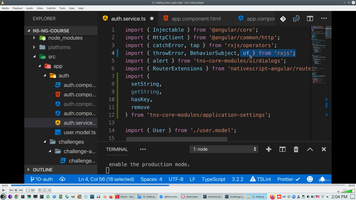

Create Observable from simple boolean value

Or Restore object from Application Setting


Create Typed data fron Json.Parse

And create Observable from srestored User object



Now for create AutoLogin we can only Subscribe to Auth Service

Change Route for Autologin, in this case defaul path '' redirect /change

28. Create Lazy loading AuthModule
We need to remove Lazy loading module from Root Module, and create separate module


Configure declaration


Configure Router path and loaded component


AuthGuard provided by Angular, need implement CanLoad method https://angular.io/api/router/CanLoad


Click CanLoad and copy interfaces to constructor
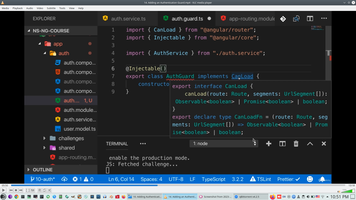




Interface require Promise wrapper of Boolean or observable wrapper of Boolean

Use Take from RxJs inside Pipe - https://rxjs.dev/api/index/function/take

Use SwithMap and Tap from RxJs

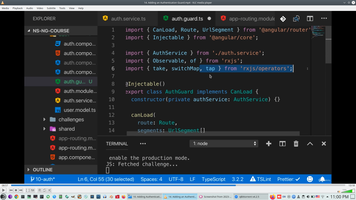
AuthGuard loaded as provider

Configure main route module

29. And finally made authorization on Firebase, each user has own chalenge in Firebase.
Firstly we need to add additional suffix to URL

And check this, each user has own key on Firebase
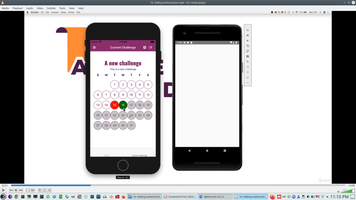

One chalenge to all user can be deleted now

Import Subscription from RxJs https://rxjs.dev/api/index/class/Subscription

Subscribe to store user info
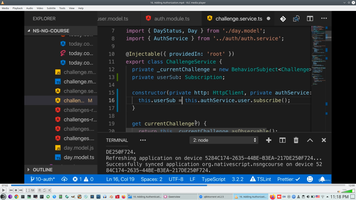
Generate empty user by BehaviorSubject Next

And finally check how Authorization working in firebase

Change Firebase rules to firbid access for other user's token


This is full final code code of this service



30. Deploynment.
- 1. Module Introduction
- 2. The Publishing Process
- 3. Testing our App on Different Devices
- 4. Adding the App Icon & Splash Screen Icons
- 5. Further Resources
- 6. Publishing the iOS App
- 7. Publishing the Android App
Iphone emulator.



Bundle APK.


Related page:
Nativescript context:
Front context:
FrontLearning context:
 )
)
|
|